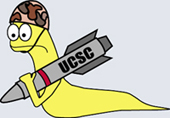University
of California Bidding on the Bomb Lab: Shuffling
the Nuclear
|
|
UC Manages Armageddon: UCSC and the Labs Research at the labs is strictly classified, which goes against university principals of academic research and peer review. The laboratories fund research projects for professors at every UC campus, and there are several collaborative research projects going on between faculty at UCSC and researchers at the labs. In the seventies several social science professors became aware of weapons research conducted on their campuses, whose laboratories were housing weapons grade plutonium and other heavily dangerous instruments for development of weapons of mass destruction. Today, most of the classified nuclear research is therefore conducted off university campuses, however that does not mean that research funded by the labs at UC campuses is not militarily relevant. UCSC Earth Sciences department recieves funding from the Los Alamos Laboratory for studies in seismic wave activities that help scientists discover when and where nuclear weapons are being tested around the world. The work of the professor contributes to the International Monitoring System for verification of the Comprehensive Nuclear Test Ban Treaty (CTBT) at the Radionuclide Laboratory in Los Alamos. By itself, this project may seem a responsible one but in conjunction with the Bush administrationís failure to ratify the Comprehnsive Nuclear Test Ban Treaty (CTBT), it allows the US a "donít do as I do, do as I say" rhetoric. The Modeling and Imaging Laboratory (MILAB) in the Geophysics department at UCSC is also funded by Los Alamos National Laboratory, as well as the Office of Naval Research, Air Force Office of Scientific Research, and many petroleum corporations including BHP, Shell, Chevron, Conoco, and Unocal. MILAB develops theory and methods for the modeling and imaging of "complex environments", assisting American corporations in the extraction of valuable natural resources available in parts of the world outside of the United States. The UCSC MILAB website states their intent clearly: "The Earth is recognized to have hierarchical, multi-scale heterogeneities, especially in economically, environmentally and/or scientifically interesting areas. As new oil and gas reserves become more difficult to find and expensive to drill for, there is increased interest in pinpointing their potential beneath increasingly complicated structures."(4) What other interest would the US military, the weapons laboratory, and these oil conglomerates have in the geography of these environments if they werenít planning on invading them? |


